Katherine Sabbath's kooky, spooky baking recipes for Halloween
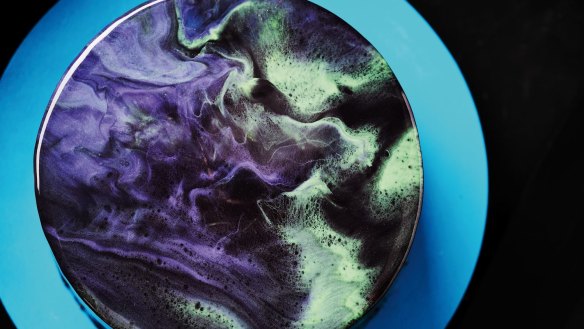
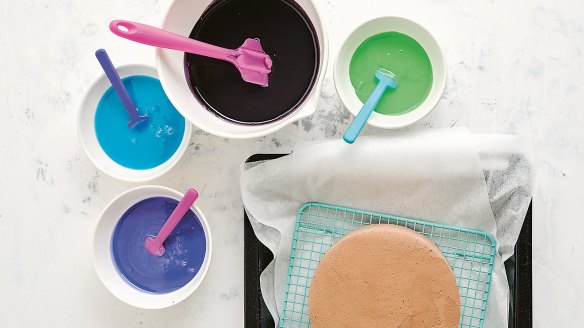
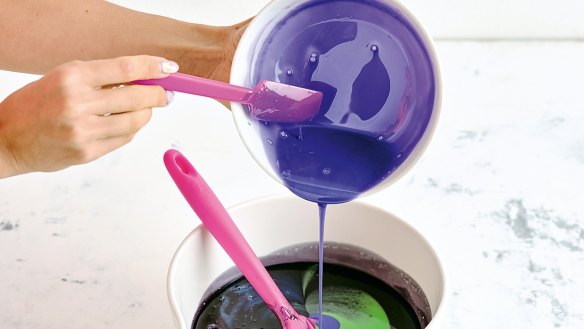
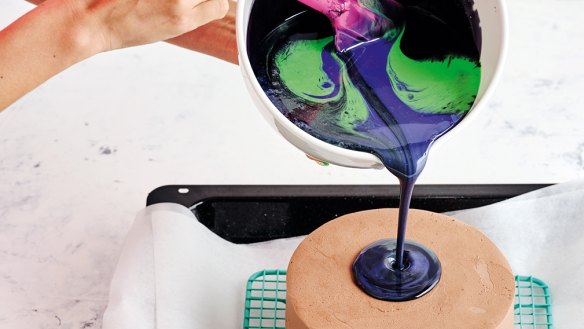
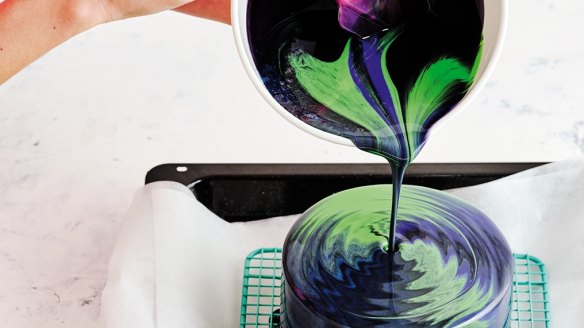
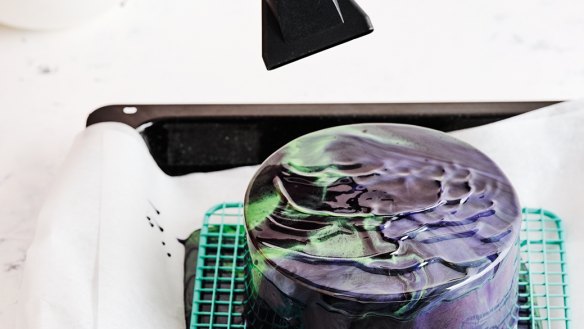
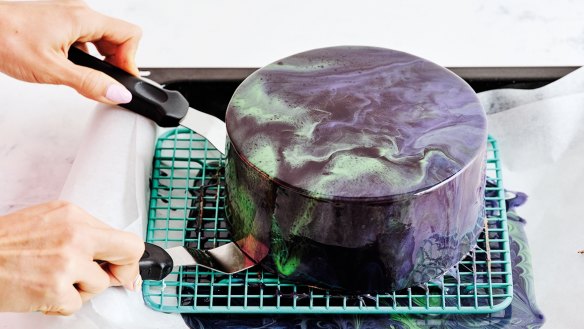
Easy (choc freckly pops), medium (redback spider cupcakes), and hard (glazed 'opal' cake) baking recipes for Halloween from cake queen Katherine Sabbath's second cookbook, Bake Australia Great.
The black opal cake
Black opals are the most valuable form of this precious stone and can be found only in Australia and North America. The stone has a dark grey or black background, in which a fiery display of glowing dark green, gold, blue, black or pale violet can be seen. The glossy mirror glaze is a traditional technique used to decorate mousse cakes (known as entremets) and pastries. Giving the glaze a quick blast of heat with a hair dryer creates an out-of-this-world effect, reminiscent of the flashes of metallic colour seen in the black opals.
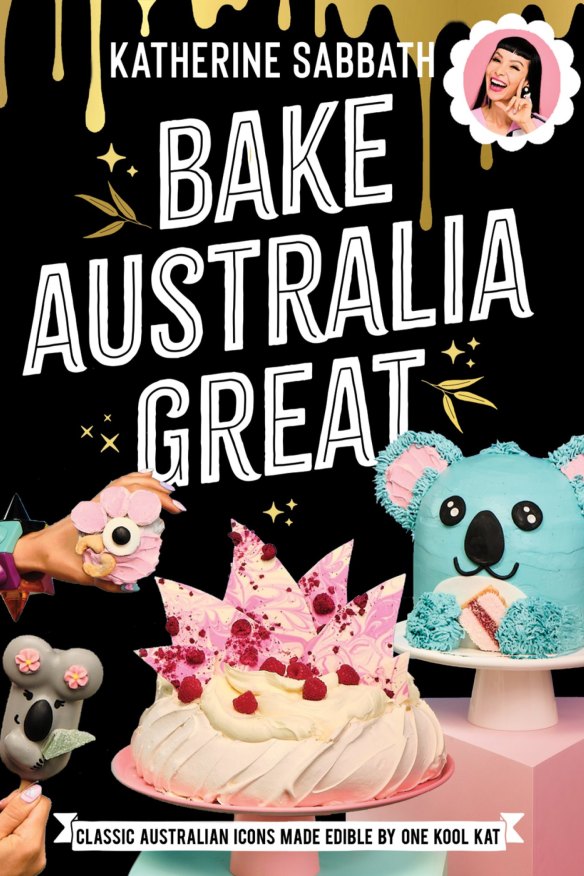
Dark chocolate sea salt cake
INGREDIENTS
- oil spray
- 1 cup (175g) chopped dark chocolate
- 1 cup (230g) coconut oil
- 2½ cups (400g) self-raising flour
- 1½ cups (330g) castor sugar
- ½ cup (55g) cocoa powder
- ½ tsp bicarbonate of soda (baking soda)
- ½ tsp sea salt
- 4 large eggs, at room temperature
- 1½ cups (375ml) milk, at room temperature
- 1 tsp vanilla extract
METHOD
- Preheat the oven to 160C fan-forced. Grease three 18cm round cake tins with cooking oil spray. Line the tins with baking paper.
- Melt the chocolate and coconut oil using either a microwave or doubleboiler. Stir until combined. Set the mixture aside to cool to room temperature.
- Using an electric mixer fitted with the paddle attachment, gently fold the dry ingredients together until combined.
- With the mixer on low speed, slowly add the chocolate mixture to the dry ingredients. Beat in the eggs, one at a time, then beat in the milk and vanilla. Mix until combined.
- Divide the batter among the cake tins. Bake for 45 minutes or until a skewer inserted into the centre of the cakes comes out clean. Leave the cakes to cool in the tins for at least one hour before turning out onto a wire rack to cool completely.
Dark chocolate Swiss meringue buttercream
INGREDIENTS
- 1½ cups (330g) castor sugar
- 8 large egg whites
- 300g good-quality dark chocolate, chopped
- 2 cups (500g) unsalted butter, softened
- 1 tsp vanilla bean paste
METHOD
- Put the sugar and egg whites in a heatproof glass bowl. Set the bowl over a pan of gently simmering water and whisk until the sugar has dissolved and the mixture is slightly warm to the touch. Remove from the heat.
- Using an electric mixer fitted with the whisk attachment, beat on high speed until the mixture has formed stiff and glossy peaks (about 10 to 15 minutes).
- Meanwhile, melt the chocolate using either a microwave or double-boiler. Remove from the heat and keep warm.
- Add the butter to the meringue in three batches, beating until incorporated after each addition. (Don't be alarmed if it appears curdled – it will become light and fluffy with continued whipping). Beat in the chocolate. Add the vanilla and beat until fluffy, then beat on low speed to eliminate air bubbles. Cover the bowl with plastic wrap and set aside in a cool place until needed
Glaze
INGREDIENTS
- 12g gold-strength gelatine sheets
- 150g good-quality white chocolate, chopped
- 110ml water
- ⅔ cup (150g) castor sugar
- 100g glucose syrup
- 100g sweetened condensed milk
- Black, purple, blue and green gel food colouring
METHOD
- Soak the gelatine sheets in iced water for 20 minutes.
- Meanwhile, put the white chocolate in a heatproof bowl.
- Combine the water, sugar and glucose syrup in a saucepan and bring to the boil. Remove from the heat and stir in the condensed milk and drained gelatine sheets.
- Pour the hot sugar mixture over the chocolate. Mix with a stick blender until the chocolate is melted and smooth (or you can mix thoroughly with a spoon), being careful not to create air bubbles.
- Divide the glaze among four bowls and tint each portion with one of the gel colours until the desired shade is reached.
- Cover the surface of the glaze with plastic wrap and allow it to cool to around 35C.
- Pour all the glaze colours into one jug (being careful not to over-mix or blend) and use immediately. (Don't fret if the glaze cools before you are able to use it – gently re-heat it in the microwave in five to 10 second bursts, stirring in between.)
To assemble
METHOD
- Working on a cake turntable or lazy Susan, secure the bottom layer of cake onto a cake board with a dollop of chocolate buttercream and then gently twist in place. Use an offset spatula to cover the top of the cake with a 5mm layer of buttercream, spreading it right to the edge.
- Place the second layer of cake on top and repeat the layering process. Add the final cake layer.
- Using an offset spatula and a cake scraper, gently crumb coat the entire cake with a thin layer of buttercream. Carefully smooth the side and top until the desired finish is achieved. Chill in the fridgefridge for 10 minutes or until firm.
- Use an offset spatula to roughly apply a thick layer of buttercream all over the cake and use the cake scraper and offset spatula to smooth the side and top.
- Chill the cake in the freezer for at least one hour.
- Gently remove the chilled cake from the cake board using a hot knife and a large spatula. Place on a cooling rack or an upturned 15cm cake tin on top of a large baking tray to catch the run-off glaze.
- Working quickly, pour the coloured glaze onto the centre of the cake, then work your way out to the edge. Once the cake is completely covered, use a hair dryer to give the surface a quick blast of heat – about two seconds – to create the marbled effect. Let the glaze continue to drip and set for about three minutes, then carefully transfer the cake onto a cake board. Allow the cake to thaw in the fridge for at least one hour, then leave it at room temperature for at least one hour before serving.
Serves 12
STORAGE
- This cake is best enjoyed at room temperature. It can be refrigerated for up to five days.
- The glaze can be made ahead and refrigerated for up to a week. Gently reheat it in the microwave until the correct pouring temperature is reached – 35C. Pour all the glaze colours into one jug (being careful not to over-mix or blend them) and use immediately.
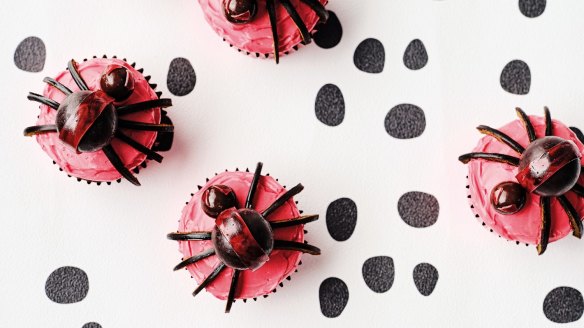
Redback spider cupcakes
Our great southern land is home to one of the world's most notoriously dangerous spiders, the redback. These cupcakes can be made as any kind of spider, but Mother Nature has told us time and time again that black and red go so well together.
Chocolate cupcakes
INGREDIENTS
- ⅓ cup (80g) unsalted butter, softened
- ½ cup (110g) castor sugar
- 1 tsp vanilla extract
- 2 eggs, at room temperature
- 1 pinch salt
- 1 cup (160g) self-raising flour
- ⅓ cup (35g) cocoa powder
- ¾ cup (185ml) milk, at room temperature
METHOD
- Preheat the oven to 160C fan-forced. Line a 12-hole cupcake tray with cupcake cases.
- Using an electric mixer, cream the butter, sugar and vanilla until light and fluffy. Add the eggs, one at a time, beating until combined. Add the salt.
- Alternately fold in the flour, cocoa and milk, in one-third increments. Fold until just combined.
- Divide the batter evenly among the cupcake cases, filling each one about three-quarters full.
- Bake for 20 minutes or until a toothpick inserted into the centre of one of the cupcakes comes out clean. Remove from the oven and transfer to a wire rack to cool completely.
Vanilla buttercream
INGREDIENTS
- 50g unsalted butter, softened
- 1½ cups (210g) icing sugar, sifted
- 1½ tbsp milk
- 1 tsp vanilla bean paste or vanilla extract
- red food colouring
METHOD
- Using an electric mixer, beat the butter until very pale. Gradually add the icing sugar while beating on low speed. Add the milk and vanilla and beat on high speed until fluffy.
- Colour the buttercream by mixing in red food colouring until the desired shade is achieved.
To assemble
INGREDIENTS
- 2 strawberry fruit Roll-Ups
- 12 large chocolate balls
- 12 small chocolate balls
- Black licorice rope
METHOD
- Use a butter knife or small offset spatula to apply a generous dollop of buttercream to each cupcake.
- Use a sharp knife or kitchen scissors to cut the fruit Roll-Ups into strips. Wrap a strip around each of the large round chocolates and place each one on the top of a cupcake to make the spiders' abdomens.
- Slice or cut small triangles of the fruit Roll-Ups to make eyes. Stick the eyes onto the smaller round chocolates to make the spiders' heads, using a little buttercream as glue, if needed. Place a head next to the abdomen on each cupcake.
- To make the spiders' legs, slice or cut thin strips from the licorice, about 4cm long. Arrange four strips on the side of each abdomen.
Makes 12
DECORATING TIPS
- If you colour the buttercream at least 24 hours ahead, you'll achieve a richer red colour. Cover and refrigerate the buttercream, then bring it back to room temperature and beat until fluffy.
- I used dark chocolate Lindt Lindor Balls for the spiders' abdomens and dark Maltesers for their heads.
- You can use any kind of red-coloured fruit straps to add the details to the spiders.
STORAGE
- The cupcakes are best eaten on the day of decorating, but they can be refrigerated in an airtight container for up to three days.
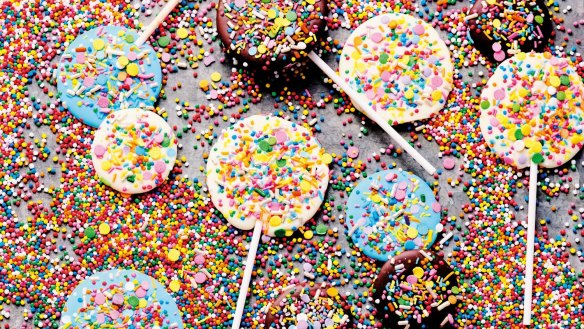
Choc freckle pops
I reckon I've popped far too many chocolate freckles in my life! I had no idea they were so super-easy to make – although perhaps I'm not to be trusted with a whole bag of hundreds and thousands? When you make these yourself, you can use your favourite chocolate (milk, dark or white) AND your favourite sprinkles. Bring lollipop sticks into the picture, and you've got a whole new party treat.
INGREDIENTS
- 300g mixture of milk, dark and white chocolate, chopped (see tips)
- blue oil-based chocolate colouring (optional)
- lollipop sticks
- assorted sprinkles
METHOD
- Line two baking trays with baking paper. Or to make your job easier, use silicone macaron trays (this will help you to form perfect circular freckles).
- Melt each type of chocolate separately using either a microwave or double-boiler. Colour the white chocolate with the blue colouring, if using.
- Working with one tray at a time, drop different-sized spoonfuls of chocolate onto the tray (or pipe chocolate circles using a piping bag). Tap the tray on the bench to form smooth circles. Place a lollipop stick in each circle and cover with some extra chocolate, if needed. Working quickly, generously cover the chocolate circles with sprinkles and tap the tray to help embed the sprinkles in the chocolate.
- Reheat the chocolate if needed to make the second tray of freckle pops.
- Set the trays aside in a cool, dark and dry place until the chocolate has set. Transfer the choc freckle pops to an airtight container (you'll have around 30 freckle pops) and save any extra sprinkles for another time
Makes about 30
DECORATING TIPS
• I used hundreds and thousands, rainbow jimmies (sprinkles) and edible confetti to make the freckle pops.
• If you are using any type of couverture chocolate (my personal favourite), which contains a high cocoa butter content, you will need to temper (also known as 'crystallise') the chocolate. This will give the best taste, texture and overall results. Chocolate melts (compound chocolate) will also work well and you won't need to temper the chocolate, so the process will be easy as!
STORAGE
• Store the freckle pops in an airtight container for up to one month in a cool, dark and dry place
Images and text from Bake Australia Great by Katherine Sabbath, photographer Jeremy Simons, styling Emma Knowles, Murdoch Books RRP $39.99